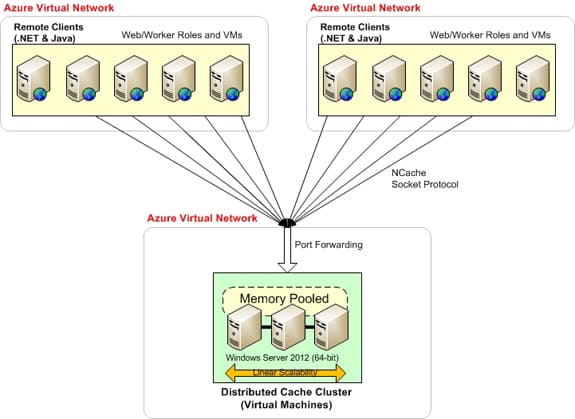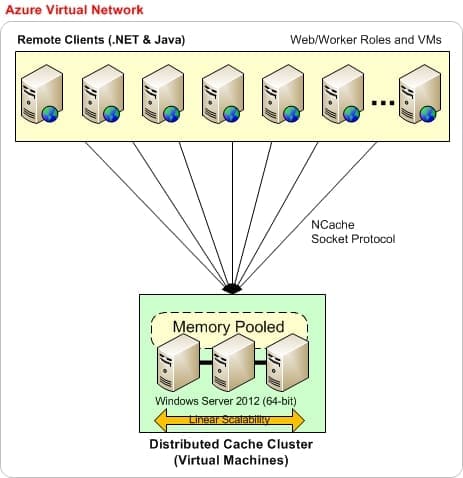.NET Distributed Cache for Microsoft Azure & AWS
NCache is available in the Azure and Amazon clouds under a Bring-Your-Own-License (BYOL) model. NCache in the cloud lets you cache application data, store ASP.NET Session State, and cache ASP.NET View State for applications running in a multi-server configuration.
Deploy NCache Cloud in Azure and AWS
In this configuration, you create a dedicated distributed cache by allocating two or more NCache Cloud Virtual Machines and creating the cache on them. This cache is then accessible through the publicly addressable endpoints of Microsoft Azure & AWS Virtual Network.

The benefits of this configuration are as follows:
- Use the Cache from any Microsoft Azure/AWS application and website
- Share the Cache across multiple Microsoft Azure apps and even to other platforms like AWS, Google Compute Engine, Rackspace, your private cloud and more
- Share the Cache across multiple regions for the same or different applications
Deploy as Virtual Machines
In this configuration, you allocate two or more NCache Virtual Machines as your caching tier and collocate this caching tier with your application in the same Virtual Network. Your .NET application can run as Web Role, Worker Role, or on its own Virtual Machine accessing this caching tier through a direct TCP connection to the cache cluster and without going through any publicly addressable endpoint.

The benefit of this configuration is its speed and total privacy. The cache is very close to your application and therefore very fast because it does not go through any extra hops.
Deploying with PaaS in Azure & AWS Cloud
Customers can run their applications using NCache in a Platform-as-a-Service (PaaS) offering. In PaaS offerings, such as Azure ASP.NET Websites and Azure ServiceFabric (microservices), the customer does not install and configure each app server VM/"container" to run applications. Instead, this function is handled by the cloud platform, which automatically starts/stops the app server VMs or "containers" without involvement from the customer.
The NCache server-only license supports PaaS app deployments. With this license, the NCache Remote Client does not require either licensing or installation. Instead, the NCache Remote Client libraries are embedded with the application. When the application is deployed on a PaaS, the NCache Remote Client libraries are deployed as well.
Please note that the NCache server will need to be explicitly installed on separate VMs/”Containers” with a minimum of two cache servers. PaaS-deployed applications can then access these cache servers seamlessly.
Please also note that this approach supports only InProc Client Cache functions. OutProc Client Cache functions require an NCache service process to host it. This service process is installed through a Client Cache Windows Installer (.msi).
What to Do Next?
Download Free 30 Day Install KeyRequest a Personalized LIVE Demo